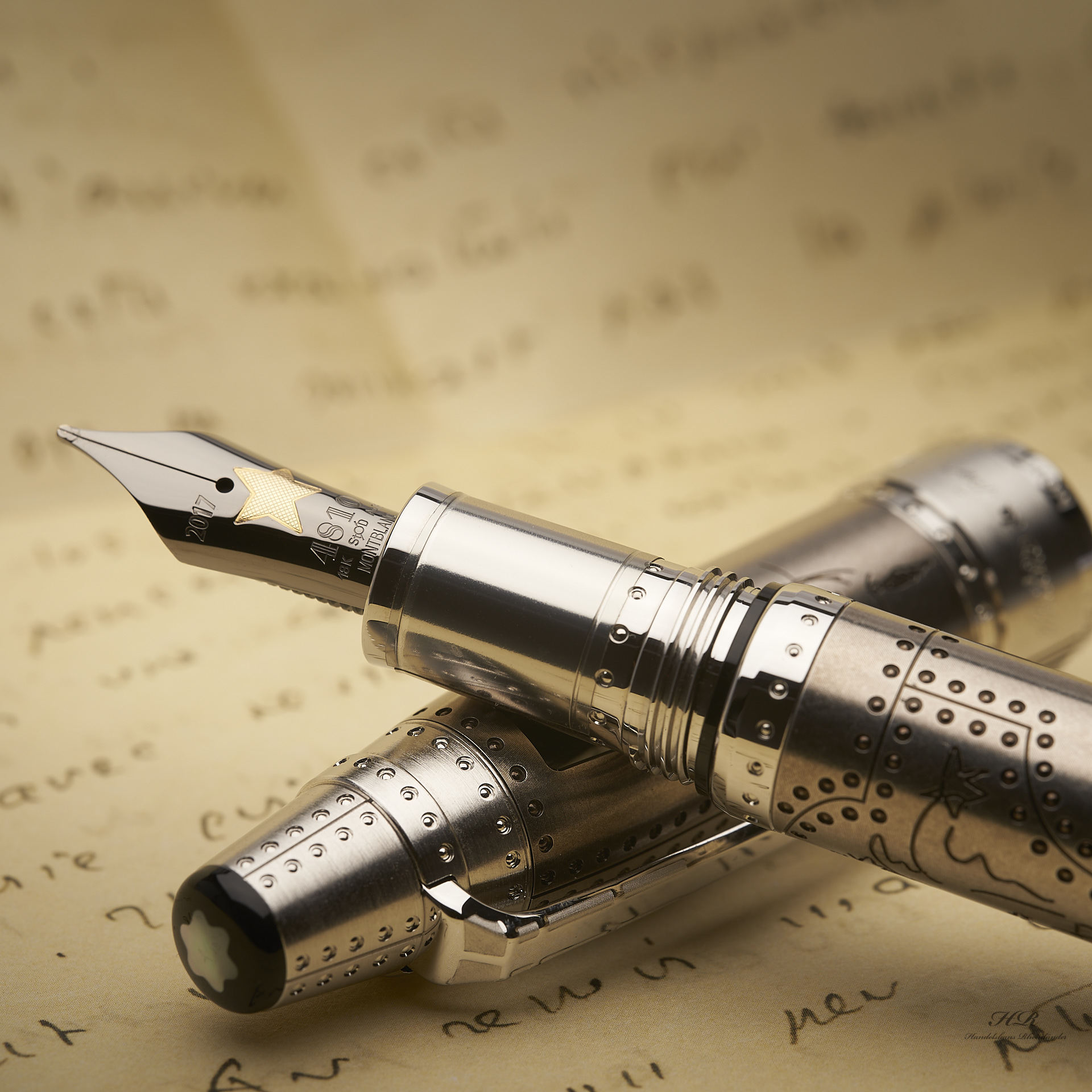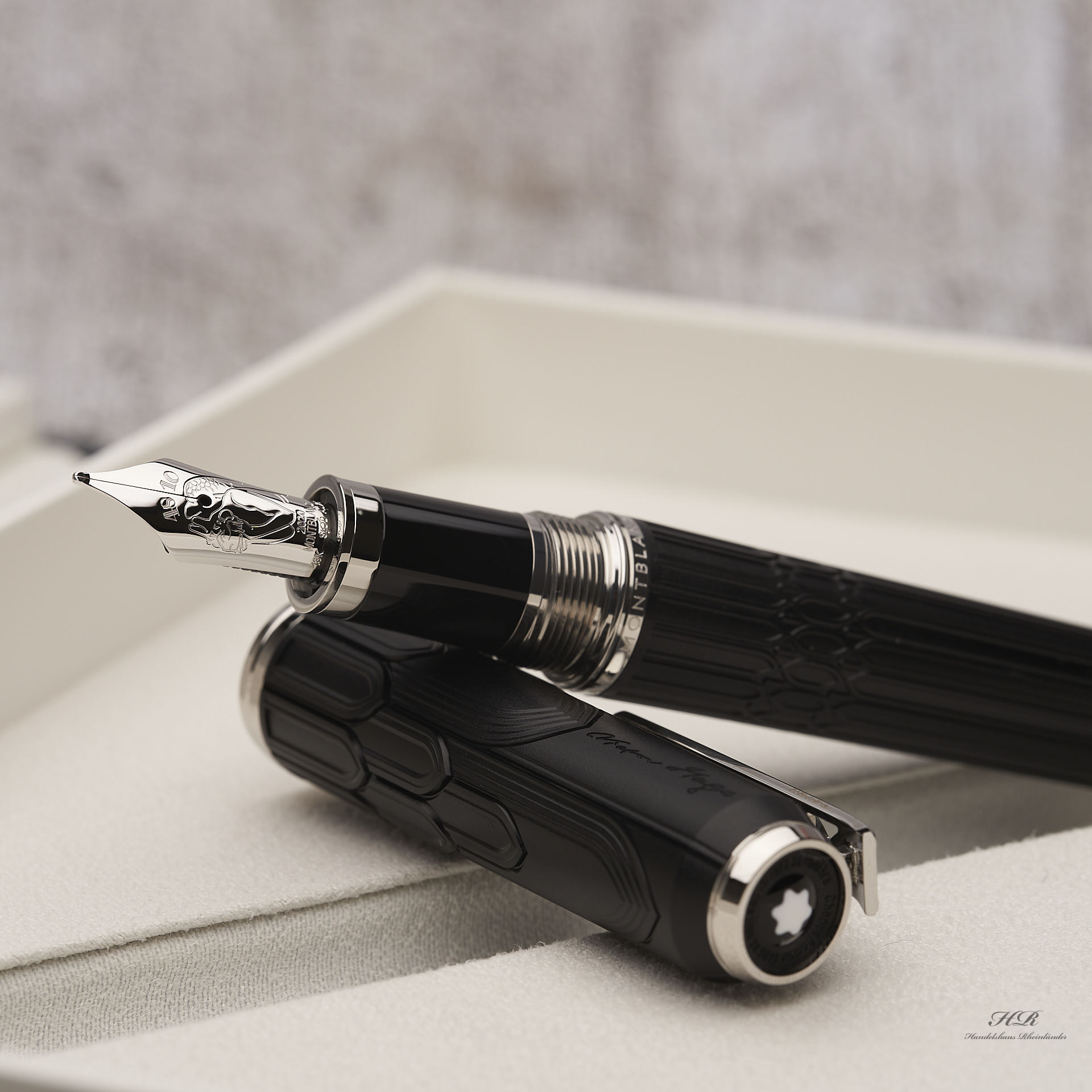Montblanc Pen
The Montblanc writing experience
Writing by hand is fundamentally different from mechanical forms of writing. While the latter may be faster and indispensable for large amounts of information to be conveyed, writing by hand is generally more focused. In any case, the scientifically extensively studied coordination between head and hand "does" something to people who write by hand. The gentle glide of a nib on paper and the constant flow of ink give writing a sensual component; it is simply fun to write something beautiful and light as a feather with a fountain pen in the best sense of the word.
 Of all forms of handwriting, writing with a fountain pen is without doubt the most intense and sometimes also the most emotional. More than with any other writing instrument, it is a way to show appreciation to another person: Anyone who holds a letter written with a fountain pen in his or her hands knows that the other person has taken the time to do just that.
Of all forms of handwriting, writing with a fountain pen is without doubt the most intense and sometimes also the most emotional. More than with any other writing instrument, it is a way to show appreciation to another person: Anyone who holds a letter written with a fountain pen in his or her hands knows that the other person has taken the time to do just that.
Generations of students have learned to write using "Schönschreib"-fountain-pens. In the process, many have developed their own typical handwriting by which you can be clearly identified. Like a fingerprint, the way someone writes characterises a person. Handwriting is a personality trait that can be developed and shaped. Graphologists try to draw conclusions about a person's character from their handwriting and in any case, there are people who literally fall in love with someone else's writing. Therefore, the love letter written with a fountain pen is clearly preferable to the love email.
As a cultural brand, Montblanc is committed to the tradition of handwriting because communicating in writing is an indispensable part of art and culture. Communicating in writing, being able to express oneself and to convince and inspire others with ideas is a gift that successful people use. Nothing is better suited for this than a Montblanc fountain pen.
Even in the business world, handwriting holds keeps its relevanvce. When it comes to agreeing to a contract, signatures are made using a fountain pen - even though digital solutions are available for this purpose - and at major events of global significance, they are also signed in front of running cameras.
Lifelong companions
Once you have discovered fountain pens, they grow on you, or rather on your hand. At any rate, this is where the saying comes from that fountain pens should not be borrowed to a third person. There is a grain of truth in this saying, because: A noble fountain pen "gets used" to its owner - to the way it is set on paper, at what angle and with what pressure, and many things more. A Montblanc fountain pen writes perfectly right from the start; the quality with which it is produced knows no compromises. No newly delivered nib from Montblanc scratches, the ink flow is constant and perfect. Nevertheless, over time, the nib resonates even more with the people who use a Montblanc fountain pen. And for this reason, it is not a consumer product like any other - it is designed using high craftsmanship to be a life companion that can even be passed on to the next generation.
Montblanc Meisterstück
With the "Meisterstück 149", Montblanc succeeded in creating an icon in the field of writing instruments in 1952. The Meisterstück family, which has been part of the Montblanc range since 1924, comprises far more than just this unique piston fountain pen made of black precious resin with gold-plated fittings. However, the perfection and genetics of this greatest Meisterstück can be found again in all the other members of the Meisterstück family that have been issued since, including the round, flowing shapes and the 3-ring design of the cap, as well as the typical clip and, of course, the white Montblanc star as the crowning touch on the cap.
Until the mid-1980s, the barrel and cap of the Meisterstück family were always made of hand-polished precious resin, mostly deep black, with a later collection in Bordeaux red. In addition to the classic piston fountain pens, there were and are also cartridge and converter fountain pens as well as other writing systems. The company's internal model names such as 145, 146, 161, 163, 164, 167 etc. conceal ballpoint pens, propelling pencils, rollerballs and fountain pens of the Meisterstück family in various sizes. They complement the fountain pens perfectly. While pencils are by nature very good for drawing, ballpoint pens are the perfect choice when it comes to quickly writing or jotting something down for yourself. Rollerballs offer the opportunity to combine the best of both worlds: speed and the noble effect of real ink on paper.
The masterpieces, which were initially produced exclusively with yellow gold fittings, were later also produced with platinum and red gold fittings, and even the iconic 149 is now also available with platinum and red gold fittings. All masterpieces are handcrafted by Montblanc in Hamburg.
 More familiar to customers are their product names such as Mozart (the smallest line), Classique (the middle line) or LeGrand (the second largest line after the 149). For a short time, the Classique was named Chopin and the LeGrand Beethoven. What all Meisterstück pens have had in common since 1930 is that the number 4810 is stamped on the nib to document the brand's claim to quality. If you take a close look at the inside of the clip of a Meisterstück, you will also find an embossing there that looks like a code: "PIX" was a pencil mechanism by Montblanc that was registered as a trademark in 1937.
More familiar to customers are their product names such as Mozart (the smallest line), Classique (the middle line) or LeGrand (the second largest line after the 149). For a short time, the Classique was named Chopin and the LeGrand Beethoven. What all Meisterstück pens have had in common since 1930 is that the number 4810 is stamped on the nib to document the brand's claim to quality. If you take a close look at the inside of the clip of a Meisterstück, you will also find an embossing there that looks like a code: "PIX" was a pencil mechanism by Montblanc that was registered as a trademark in 1937.
From the mid-80s of the last century, precious metals found their way into Meisterstück production. From then on, bodies were also made with traditional jeweller's materials such as silver, vermeil or gold, or with precious stones. The Meisterstück Solitaire line, which is still regularly supplemented by new products, was created, crowned by the Meisterstück Solitaire Royal - in the meantime the most expensive writing instrument in the world - made of solid gold with an impressive number of brilliant-cut diamonds set into it: 4810!
Modern interpretations of the Meisterstück confirm the MST advertising slogan "New since 1924": stainless steel and carbon impressively document that high-touch and high-tech go together and that Montblanc is capable of bridging the gap between tradition and modernity, true to the motto that tradition is not expressed in keeping the ashes, but in carrying the fire forward. So it comes as no surprise that, in the production of the Meisterstücks, state-of-the-art technology and traditional craftsmanship do not form a contradiction, but complement each other perfectly.
The Doué versions of the Meisterstück series combine a body made of precious resin with caps from the Solitaire lines. Precious metal, wood, leather and many others are used.
Special series of the Meisterstück were also created for various themes and occasions, e.g. Tribute to the Montblanc as a tribute to the company's namesake in snow-white precious resin. Great Masters or Meisterstück Le Petit Prince in dark blue as well as Meisterstück 1924 as a special series for the 75th anniversary are some of the other important Meisterstück series.
In addition to the Meisterstück, two other unlimited lines were added in the 2000s that have since become characteristic for Montblanc: StarWalker and Bohème. While the former convey a touch of avant-garde with their emphatically simple lines, Bohème stands for the connoisseurs and refined spirits and tends to be more opulent, but without being overblown or slipping in the direction of bling-bling.
The nibs are the heart of a Montblanc fountain pen. The nibs used for Meisterstück fountain pens are made of 14ct or 18ct gold (in the case of the 149 and the Solitaire lines), most of them elaborately rhodium-plated and designed in a bicolour look. Common to all of them since 1930 has been the embossing of the number 4810 and, above all, the perfect matching of the springs, which are handmade in several dozen steps. The wings can swing freely and the iridium tip of the nib, which is hand-ground to the desired width, guarantees the nib a proverbial eternal life.
Depending on the product line, there are up to 8 nib widths. In addition to the nib width M, which is most suitable for most people, there are others ranging from EF as in extra fine to OBB, which stands for a slightly obliquely ground extra wide nib. Wide or extra-wide nibs are particularly suitable if the writer writes large, perhaps even expansive, and of course for signatures. Fine or extra-fine nibs do a good job when the typeface is naturally smaller, or when writing with it in a notebook or agenda.
A Montblanc writing instrument is something very personal, an accessory that you may have received as a gift on a special occasion and which is therefore more than just an object: a souvenir anchor, which, by the way, is also a very good gift to give yourself as a treat.
Montblanc writing instruments are therefore the perfect gift - a piece of jewellery for the owner that also writes. Accordingly, they are lavishly packaged like jewellery. Engravings in various typos offer the possibility of individualisation and personalisation.
The triumph of the fountain pen ran parallel to the developing mobility of people at the beginning of the 20th century. It therefore made sense to develop writing accessories that are closely related to the use of writing instruments when travelling.
First of all, there are the leather cases that hold one or even up to three of the precious writing instruments. The Montblanc pens are tidy, easy to find and perfectly protected from mechanical damage. In terms of material selection, workmanship and design, Montblanc's cases are genuine masterpieces and the adequate form of storage for a travelling masterpiece, to which they are also perfectly matched in terms of dimensions.
After all, fountain pens, rollerballs, ballpoint pens and propelling pencils also need to be replenished from time to time when on the move in the form of ink, rollerball pens, ballpoint pens or pencil leads. For a variety of reasons, it is advisable to use Montblanc products here too. For example, the pH value of Montblanc ink, whether it comes from cartridges or the inkwell, is perfectly matched to the materials of a Montblanc fountain pen and the colour pigments used are selected so that they do not impede the flow of ink. Montblanc rollerball refills are precision instruments in their own right, in which a ball with indentations like a golf ball, manufactured with minimal material tolerances, applies the ink to the paper without the refill running out. Biros and pencil refills from Montblanc are also simply the first choice when it comes to "refilling" a Montblanc writing instrument.

